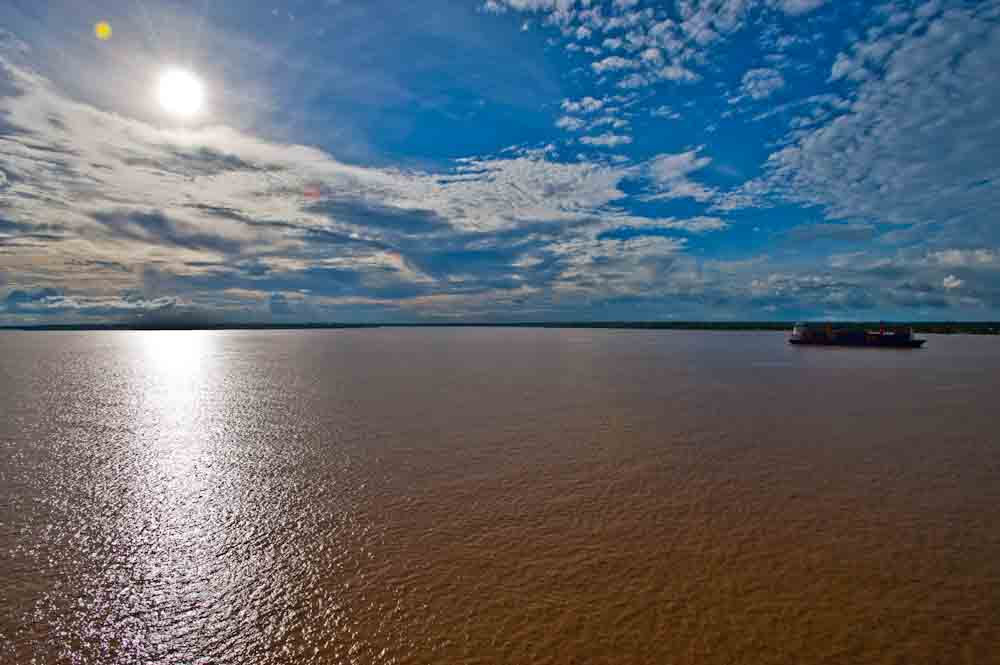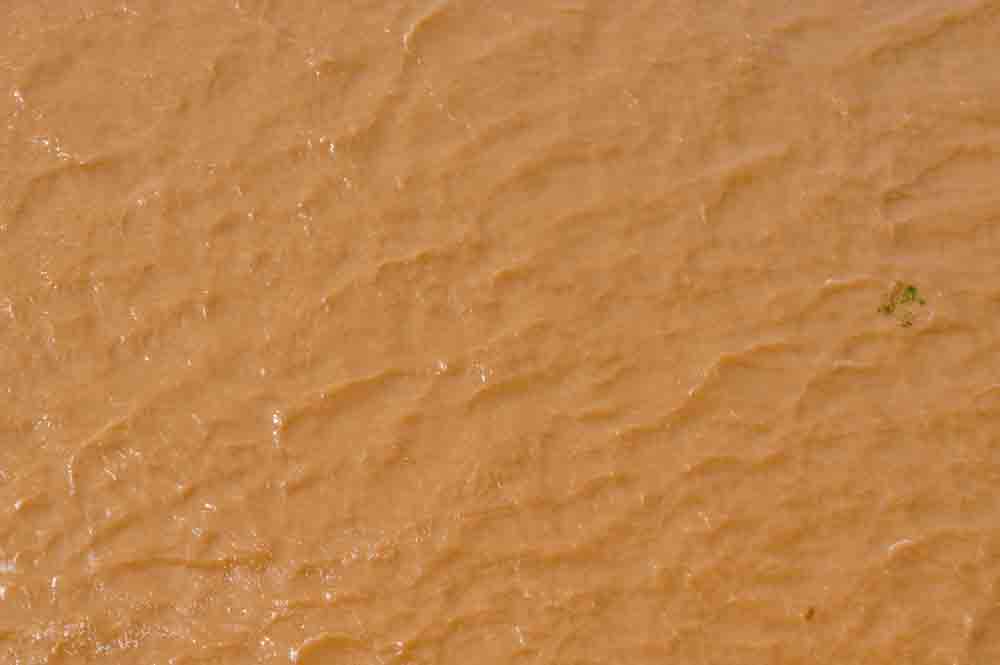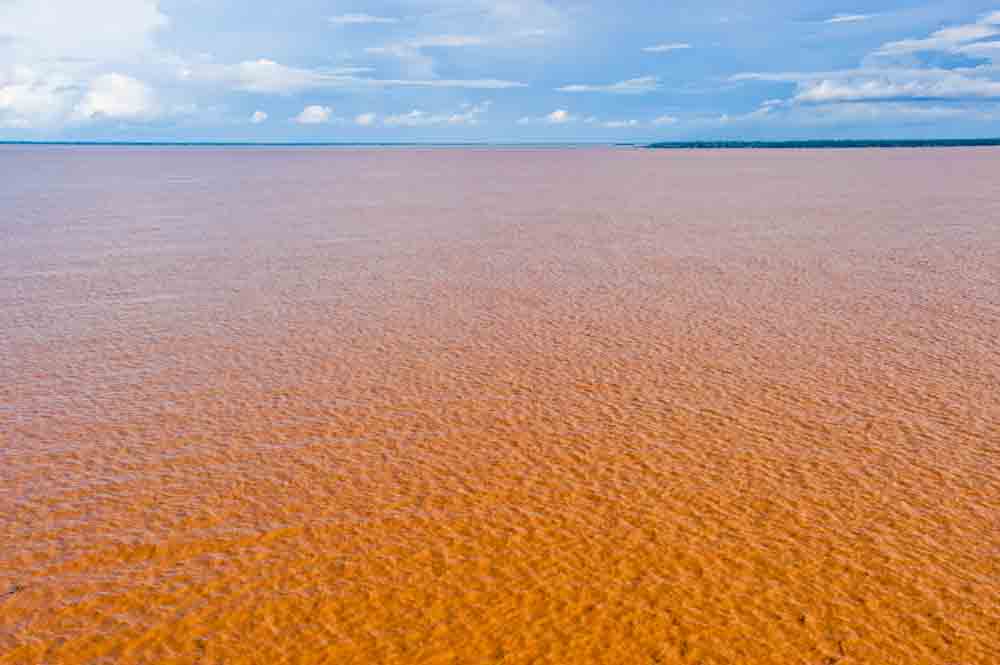
OK, I’ll admit. This title may not be for everyone. But, if you were as big an Amazon.com shopper as I am you would get the joke. It’s hard to say Amazon WITHOUT saying “dot com” after it! And, I’ll get the other one out of the way right away. This subject is clear as mud. Just look at the picture of the Amazon I took today off our veranda. Ha, ha, ha.

This isn’t my morning latte. This is the Amazon River!
Yesterday, the Amazing Terry Breen, our resident expert on South America and Jean-Michel Cousteau, the infamous oceanographer, gave presentations on the Amazon. This article is intended to pass on the highlights of those talks about one of the most amazing (pardon the pun) places on earth. I’ll give it to you in snippets.
– The biggest disappointment for most cruise passengers is the Amazon River. Why? Because the Amazon River is absolutely huge. Much different from the picture painted by Hollywood. Instead of a slow moving, narrow muddy river with overhanging jungle it is really wide (more stats on that in a bit). In order to more accurately represent the Amazon region it is now called the Amazonian Rain Forest.
– In square miles, the Amazon basin would cover the entire continental United States and covers 40% of South America! Seriously, it is as big as the ENTIRE United States. That’s really big and changes the whole way you view this area. You cannot generalize things like “if you go to the Amazon you can get Malaria”. The area where Malaria is endemic is on the area bordered by Columbia, Venezuela and Brazil and is literally thousands of miles from where we will be in Manaus. It would be like saying you can get Malaria in Seattle when it exists only in Atlanta.
– The Amazon Fan, that area defined by the waters exiting the Amazon and spilling out into the Atlantic ocean extends over 100 miles. The brown fresh waters of the Amazon mix with the clear salt water of the Atlantic to create a brownish (called “brackish”) mix of the two.

View of the entrance to the Amazon. Over 7,000,000 cubic feet of this muddy colored water pass here every minute!
– The Amazon is the largest river system in the world as well as the largest river. It is not yet the longest (that’s the Nile) but the Nile is only 75 miles longer. First explored in 1547 it took 2 years for Francisco de Orellana to go from the largest tributary in Ecuador all the way to the Atlantic.
– During rainy season, the average width of the river is 30 miles with some parts extending 120 miles in width. The mouth is over 200 miles wide. There is an island in the middle bigger than Switzerland. There is a consistent 5 knot current moving towards the Atlantic. The average depth in the rainy season is 75 feet but there are portions over 300 feet deep. Pororoca, a tidal flow that is 22 feet high occurs from time to time and this flow moves in several waves at 6 mph and push up to 500 miles inland. Surfers even come to the Amazon to surf on these waves!

I don’t know how to say it other than the Amazon produces a LOT of water. The volume flow is larger than the next 10 largest rivers combined! In one day, more water goes through the Amazon than an entire year in the Thames. Nearly 20% of the world’s runoff comes from this one river and one days discharge could supply all the US water requirements for a year. Here are comparative flow stats:
Nile – 651,000 cu ft/ second
Mississippi – 1,500,000 cu ft/second
Congo – 1,600,000 cu ft/second
Amazon – 7,000,000 cu ft/second
– The Amazon River system is comprised of over 1,000 rivers that are over 1,000 miles in length. Of course, there are many, many more that are smaller.
– You can fly for hours in any direction and not see a rise in the tree line. This area was once the bottom of an inland sea and this former seabed is hard packed clay that is only 2 inches thick. Amazingly (sorry for the pun again…it just seems to apply) the Amazon only descends 345 feet (105 m) from the Peruvian river port of Iquitos, a full 2,300 miles from the ocean. Thus the river descends at a rate of only 1.8 inches per mile! That’s REALLY flat and not what most people expect to see.
– Over millions of years, as the South American continent drifted away from Pangea (the large land mass that formerly consisted of a larger area of South America and Africa among others) the Andes mountains were forced up and the Eastern coastal areas of Brazil were forced down. This forced the water from the inland lake to start flowing into the Atlantic Ocean, creating the Amazon River basin.

The meeting of the water…above see the chocolate colored water mixing with ocean water.
There are three types of water in the Amazon:
Main branch: White water. Milky, chalk/reddish brown. pH 6.9. Lots of nutrients. Supports vegetation. Floating clumps or “rafts” of living water hyacinths and grass.
Rio Negro: Black water. Filled with tannins. Golden black color. Free from sediment and low in nutrients. pH 4.9-5.3. Fairly acidic. Not much lives here.
Tapajos: Clearwater. pH: neutral. Has some vegetation.
When the black water meets the white water, in an area called the meeting of the rivers around Manaus, it takes 5 miles for it to combine. In the meantime, it has a very clear demarcation between the milky brown and darker waters.
– There is a diversity of plant life in the rain forest but that’s a whole story unto itself. The sad thing is that damaging any part of the ecosystem can have unforeseen effects on other areas. For instance, the trees root system is only a couple inches deep so they spread like tentacles. Each tree actually supports other trees. So cutting down one can cause many others to fall.
– One of the more interesting creatures in the Amazon is the pink dolphin. While they look somewhat similar to the dolphins we are used to seeing they are (surprise!) pink. They also have a larger bulb on the front of their “head” and a much longer and thinner snout. The bulb area provides more acoustic capabilities since they have very poor eyesight and, let’s face it…it’s hard to see in a chocolate milk river! They use the bulbous region of their head like “radar” to catch fish.
That’s it for now. Looking forward to exploring more of the Amazon and reporting it back to you!
Amazon Picture Gallery: http://travelwithdm.smugmug.com/Travel/South-America/Amazon-Mar-1-2010/25178236_xtvDSD#!i=2065153824&k=HzjqG2T


.jpg)
Marlene Shirley - Wow! So do I understand…the pink dolphins actually swim around in that “chocolate milk river”? Sounds like you are having a great time. Love, Marlene